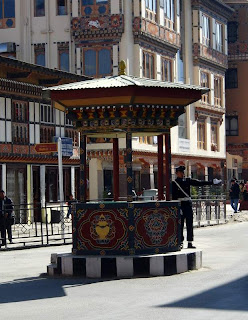This entry is written in the waiting area of the Paro Airport. I’m on my way home.
The last few days here have been most enjoyable. I already wrote about my lovely meal with Damcho and her family. The day after, Christmas Day, I had a nice walk around Thimphu, taking pictures of day to day life. Sunday I walked to the radio tower and then to a monastery; I’ve already written about that. I had an interesting incident in that I met two utterly sweet teenage girls who started chatting with me (all the kids love to practice their English) and when they found out I was an American doc, wanted their picture taken with me. So, their dad took a picture of these two kids resting their heads on my shoulders. My error was in not asking him to use my camera to take a picture as well.
Sunday was also Boxing Day, and I was invited to the home of some Christian Indian contract nurses. I had a delicious authentic Indian meal and found myself trying to explain Judaism, to some degree, to folks for whom I was probably the first Jew they met. I was asked if I was baptized, and said no. They were really surprised. I explained about circumcision, and a light went off—“Ah! Like the Muslims!” I said yes, but actually the Muslims are like the Jews, not the other way around. Incomprehension again. Oh, well. Anyway, it was a blast to spend time with these nice people.
Monday I went out to dinner with “Mr. Pete” and his family. Pete Cueva is a great guy, retired nurse anesthetist who has been volunteering here as well. He had been joined by his wife and daughter who are utter delights. I had been given a bottle of champagne by my jaw abscess patient for my help, and I had the Cuevas, “Dr. Trish”, and the Smiths over for the champagne after dinner. Dr. Trish is Trish Shands, an orthopod from Alaska—great lady, great doc, apparently also a great drummer but I know that only by reputation. The Smiths are Sue and Dave—Sue is a PT and they have been here for four months. Sue has been my partner in crime in getting physical therapy started in the ICU. Also wonderful people. We talked way past bedtime, but the other HVO volunteers have been a major positive in the experience.
Tuesday, my nurses and two of the docs I worked with gave me a going away party. Again, great home cooked Bhutanese food. I was given a Bhutanese tie and a Buddhist embroidery of the elephant, monkey, rabbit, and bird that symbolizes cooperation and harmony. What a nice remembrance.
Wednesday, we had a last meal at M-K’s, a restaurant run by a Bhutanese Hindu catering to Japanese tourists and expats who serve wonderful Bhutanese and Indian food. Go figure, but we had wonderful thick noodle soups, fried momos, and potato filled parathas.
And here I am in the Paro airport. A number of people, nurses and the other HVO volunteers, as well as the Bhutanese docs say that I made a genuine difference. I don’t know if they are just being polite, or that maybe I started something. More on that later, after I have some time for reflection.
The only bad thing is my final couple of days in the ICU. My tetanus patient died, my arrow patient got worse, and we had two sepsis deaths within 24 hours in addition to the tetanus patient. Again, I need to reflect on this before I comment.
More later, maybe in a week or so.




















































